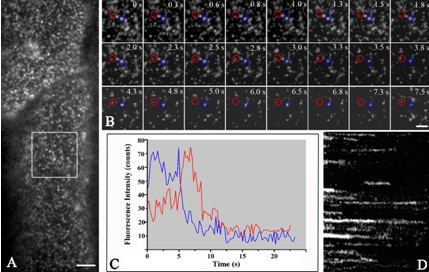The respiratory burst oxidase homolog (rboh) proteins, the homologue of mammalian 91-kD glycoprotein subunit of phagocyte oxidase (gp91phox), play important roles in plant defense responses, and the regulation of plant growth and development. These rboh proteins function as the essential regulators of ROS in responses to biotic or abiotic stresses. Although earlier studies focused on the rboh proteins functions, the detailed regulation mechanism remains unclear.
Dr. Jinxing Lin’s group investigated the dynamics of RbohD by using the variable-angle total internal reflection fluorescence microscopy combined with the single particle analyses in living seedlings. It was found that the green fluorescent protein (GFP)-RbohD mainly localized at the plasma membrane, and colocalized with the membrane marker FM 4-64, which indicate that the localization of RbohD depends on vesicle trafficking. Single particle analyses and the photobleaching method revealed that RbohD organized into dynamic spots, and these RbohD spots have heterogeneous diffusion coefficients and oligomerization states. When treated with DPI, the diffusion and oligomerization of RbohD changed. The inhibitor of Rboh proteins and ionomycin activates the ROS-producing enzymatic activity of RbohD. Under salt stress, GFP-RbohD assembled into clusters and then internalized into the cytoplasm.
Single-particle analysis in clathrin heavy chain2 mutants and a Flotillin1 artificial microRNA line demonstrated that clathrin- and microdomain-dependent endocytic pathways cooperatively regulate RbohD, and salt stress stimulates RbohD endocytosis via membrane microdomains. Taken together, these results provide insights into the heterogeneous distribution, the dynamics and endocytosis of RbohD spots. Furthermore, these findings revealed the self-regulation mechanism of plants by regulating the dynamics and endocytosis of RbohD in response to abiotic stress.
The research work was recently published online in the Plant Cell (doi: http://dx.doi.org/10.1105/tpc.113.122358). The study was supported by 973 programs and NNSFC projects.
 Dynamics of GFP-RbohD foci at the plasma membrane in Arabidopsis seedlings
Dynamics of GFP-RbohD foci at the plasma membrane in Arabidopsis seedlings
 Effects of salt stress on the localization and dynamics of GFP-RbohDa
Effects of salt stress on the localization and dynamics of GFP-RbohDa
The respiratory burst oxidase homolog (rboh) proteins, the homologue of mammalian 91-kD glycoprotein subunit of phagocyte oxidase (gp91phox), play important roles in plant defense responses, and the regulation of plant growth and development. These rboh proteins function as the essential regulators of ROS in responses to biotic or abiotic stresses. Although earlier studies focused on the rboh proteins functions, the detailed regulation mechanism remains unclear.
Dr. Jinxing Lin’s group investigated the dynamics of RbohD by using the variable-angle total internal reflection fluorescence microscopy combined with the single particle analyses in living seedlings. It was found that the green fluorescent protein (GFP)-RbohD mainly localized at the plasma membrane, and colocalized with the membrane marker FM 4-64, which indicate that the localization of RbohD depends on vesicle trafficking. Single particle analyses and the photobleaching method revealed that RbohD organized into dynamic spots, and these RbohD spots have heterogeneous diffusion coefficients and oligomerization states. When treated with DPI, the diffusion and oligomerization of RbohD changed. The inhibitor of Rboh proteins and ionomycin activates the ROS-producing enzymatic activity of RbohD. Under salt stress, GFP-RbohD assembled into clusters and then internalized into the cytoplasm.
Single-particle analysis in clathrin heavy chain2 mutants and a Flotillin1 artificial microRNA line demonstrated that clathrin- and microdomain-dependent endocytic pathways cooperatively regulate RbohD, and salt stress stimulates RbohD endocytosis via membrane microdomains. Taken together, these results provide insights into the heterogeneous distribution, the dynamics and endocytosis of RbohD spots. Furthermore, these findings revealed the self-regulation mechanism of plants by regulating the dynamics and endocytosis of RbohD in response to abiotic stress.
The research work was recently published online in the Plant Cell (doi: http://dx.doi.org/10.1105/tpc.113.122358). The study was supported by 973 programs and NNSFC projects.
 Dynamics of GFP-RbohD foci at the plasma membrane in Arabidopsis seedlings
Dynamics of GFP-RbohD foci at the plasma membrane in Arabidopsis seedlings
 Effects of salt stress on the localization and dynamics of GFP-RbohDa
Effects of salt stress on the localization and dynamics of GFP-RbohDa
